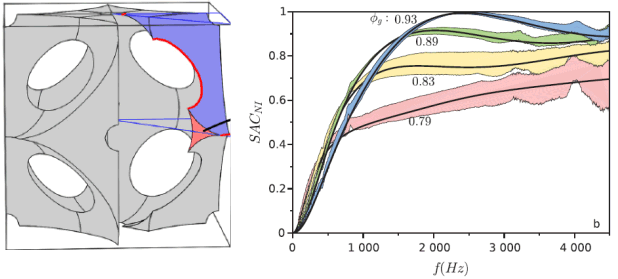
Acoustics of monodisperse open-cell foam: An experimental and numerical parametric study
- Post by: olivier.pitois
- 24 December 2020
- No Comment
J. Acoust. Soc. Am. (2020) 148, 1767-1778
Acoustics of monodisperse open-cell foam: An experimental and numerical parametric study
V. Langlois, A. Kaddami, O. Pitois, C. Perrot
Abstract: This article presents an experimental and numerical parametric study of the acoustical properties of monodisperse open-cell solid foam. Solid foam samples are produced with very good control of both the pore size (from 0.2 to 1.0 mm) and the solid volume fraction (from 6% to 35%). Acoustical measurements are performed by the threemicrophone impedance tube method. From these measurements, the visco-thermal parameters—namely, viscous permeability, tortuosity, viscous characteristic length, thermal permeability, and thermal characteristic length—are determined for an extensive number of foam samples. By combining Surface Evolver and finite-element method calculations, the visco-thermal parameters of body centered cubic (bcc) foam numerical samples are also calculated on the whole range of solid volume fraction (from 0.5% to 32%), compared to measured values and to theoretical model predictions [Langlois et al. (2019). Phys. Rev. E 100(1), 013115]. Numerical results are then used to find approximate formulas of visco-thermal parameters. A systematic comparison between measurements and predictions of the Johnson-Champoux-Allard-Lafarge (JCAL) model using measured visco-thermal parameters as input parameters, reveals a consistent agreement between them. From this first step, a calculation of the optimal microstructures maximizing the sound absorption coefficient is performed.
https://doi.org/10.1121/10.0001995

